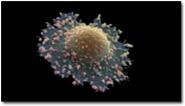1.4 Cellular responses are diverse
Cellular responses can be extremely rapid – for example, the opening of ion channels to effect a change in the membrane potential or the contraction of muscle fibres, which occur within milliseconds of signal reception, or may take minutes, such as whole cell movement, synthesis of new proteins or changes in metabolic activity. There are also longer-term responses, which may be on the scale of hours or even days, such as cell division and programmed cell death. Often several types of response may occur following a single stimulus, in a coordinated manner, and over different timescales.
Within a multicellular organism, a given cell is exposed to many different extracellular signals at any one time. The cell's ultimate response depends on the appropriate integration of these signals and on what cell type it is (for example, only a muscle cell can contract). So, for instance, signal 1 will induce a cell to proliferate but only in the presence of signal 2; in the absence of signal 2, signal 1 will induce the same cell to differentiate. The same signals may produce different responses in different cell types. In the example above, signal 1 might induce cell death in a second cell type. Different cellular responses to an extracellular signal are due at least partly to the specific receptors and intracellular signalling molecules that are active in different cell types. So, not only is the context of the signal vitally important in determining the response but also the type of target cell.
